Around 22 km from the Jodhpur city, The Bishnoi village is famous for Bishnoi tribes and various kinds of safaris. The residents of Bishnoi village are worshippers of Mother Nature and are known for excellent block-printing work and skilled shepherds as well. The locals here abide by an Eco-friendly sect of Hinduism.
Located near Jodhpur, Bishnoi village is slightly away from the limelight and thus lies off the beaten path. This creates curiosity in the minds of tourists. Our article is all about this amazing Bishnoi village in Rajasthan. We hope that it will boost your knowledge about the culture and traditions of Bishnoi village.
History of Bishnoi Village
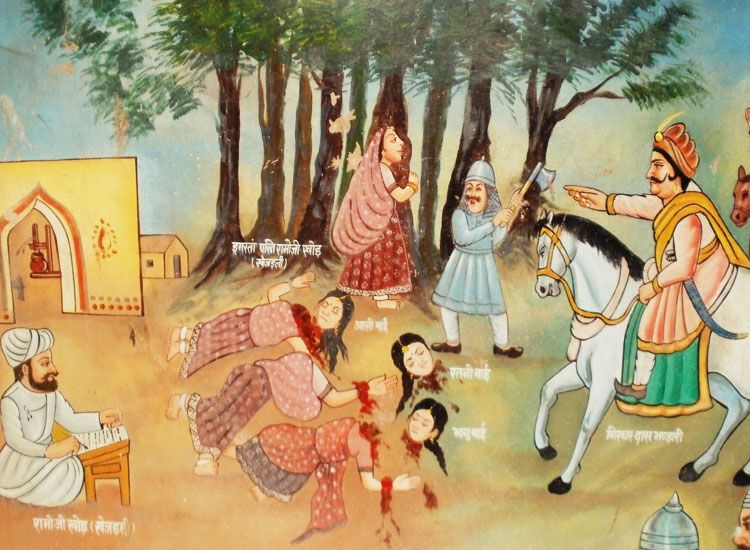
Born in 1451, Guru Jambheshwar was the founder of Bishnoi village in Rajasthan. He was known to be an incarnation of Lord Vishnu or Bishnu and thus the place for its name Bishnoi. The establishment of this sect happened after devastating results of continuous conflicts between the Hindus who resided here and Muslims, who were trying to invade. Guru Jambheshwar laid down 29 rules and principles for his followers, which also is another reason for the community’s name. 20 in Hindi is called ‘bees’ and ‘noi’ is nine and thus, Bisnoi.
The main law for the Bishnoi’s was the conservation of trees and animals from complete abolish due to ill practices of hurting the environment. At the time of his death, he declared that the locals must save the blackbuck as the animal is his manifestation. Today, this religion of nature worship is around 500 years old and is followed by more than 10 lakh people.
Culture of Bishnoi Village
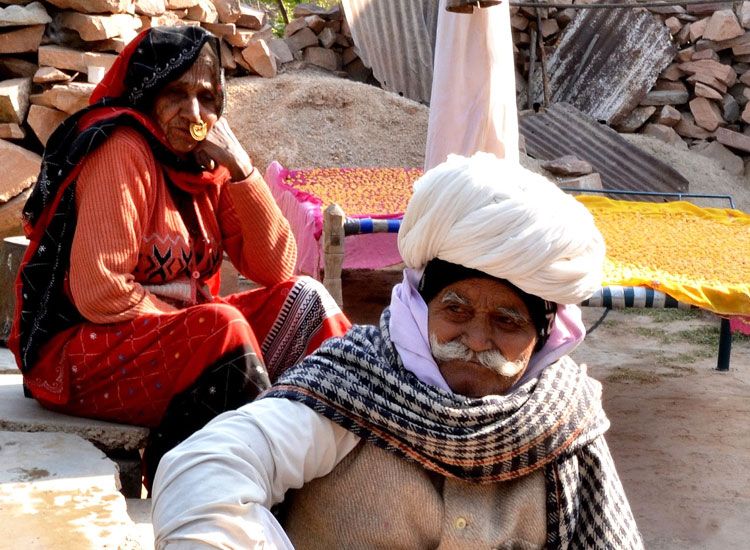
- Bishnoi villagers are known to be the worshipers of Lord Vishnu as their founder, Guru Jambeshwar was known to be his incarnation.
- They are nature lovers. The locals of Bishnoi village are known to be protectors of nature, both animal and plant species. If we see, in the main sense, nature too is their religion as directed by their Guru. The villagers save the entire ecosystem existing in the village.
- The clothes of the people are fit to tolerate the hot weather. The men wear traditional white-colored dhoti, white kurta/shirt, and huge colorful turbans. Pada, pothdi, puthia, and odhni are part of the customers of unmarried girls. Married Bishnoi ladies wear odhni, ghaghra, kanchli, kurti and dhabla. One main distinct feature of married ladies is large circular-shaped nose rings, which look very pretty.
- The food of Bishnois consists of pure vegetarian dishes.
- The locals stay in a tiny group of hamlets known as Dhanni. The huts have thatched roofs and the flooring is made from mud, which is then coated with cow dung to avoid the growth of vermin. Houses are kept extremely neat and tidy by the villagers. Special granaries are made to protect crops and other supplies from monsoon rains. Sumps are also made near every hamlet for storing water.
- Crops: The main crop grown here is bajra or pearl millet, which is done in the monsoon season. Opium is also grown here but for religious purposes.
Type of Attractions at Bishnoi Village
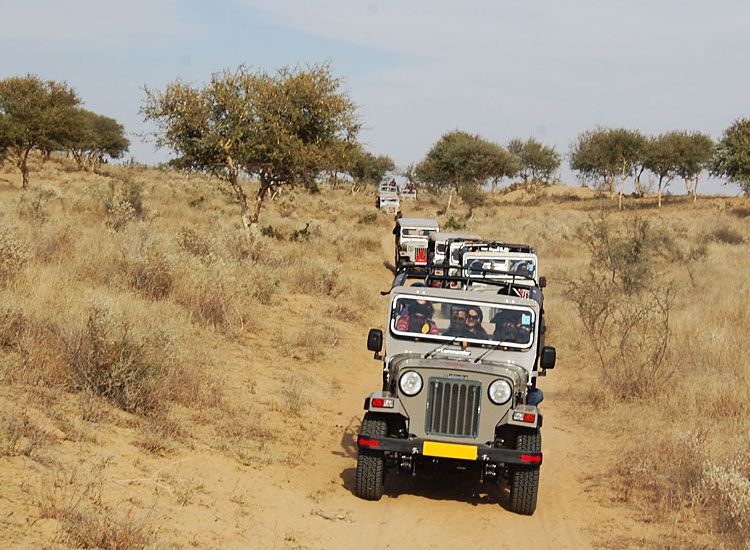
Both, full-day and half-day village safaris are offered in the Bishnoi villages. Hop into a jeep and enjoy exploring this land:
- Khejarli: This is an important Bishnoi village, which is known to be historically important. One of the main attractions here is an old temple, dedicated to the Bishnoi sect’s founder, Guru Jambheshwar. Animals like deer, blackbuck, peacocks, neel gai, etc. can be seen roaming freely here and there. The Bishnois are so protective and committed to saving the animals and trees that they are known to get extremely aggressive if they see any danger. The most popular example of this event was the event in 1730 when over 300 villagers gave their lives to save the local sacred Khejari trees.
- Salawas or Weavers village: The village is known for its wonderfully weaved carpets, which are locally known as ‘Durry’. All the weavers work together to create these fantastic hand-woven cotton rugs. The weavers buy readymade yarns from the cotton mills and make rugs. Using a fully stretched handloom length, these wavers make 3 rugs in a span of 20 days. The time taken depends on the design and size of the rug.
- Singhasni or Muslims’ Potter village: During the village safari in Bishnoi village, you get to see some of the best works of pottery here. You can also try your hand at pottery in Bishnoi village.
- Shepherds’ Village: At the Shepherd’s Village visit the families of the local shepherds. Get a glimpse of their traditional way of living. Also have a look at how they treat their animals like camel, goat, sheep, etc. Do not miss the chance to capture all this in photographs. This village also has a UNICEF-sponsored health center.
- Gudha Village and Guda Bishnoi Lake: If you wish to see how animals and humans can stay in unison, Gudha Village is the best example. Tourists can spot several bird and animal species here including blue bulls, antelopes, gazelle, rabbits, peacocks, and Demoiselle crane.
The next must-visit attraction near Bishnoi village is Guda Lake, placed close to the village. Between the months of October and March, deer, black buck, gazelles, cranes, ducks, kingfishers, chinkara, etc. can be spotted at Guda Lake. For the best views of the Guda lake, climb up a small mud hillock on the shore of the lake that is on the side of the road. If you are an avid bird watcher, you can also opt for a night stay at Bishnoi village in tourist huts, made on the hillock.
Kakani Village
Kakani is another Bishnoi village, which is quite popular for its hand-printing and pottery works. You can even attend a live pottery work session here. At the showroom, you can even get your hands on several beautiful pottery items, available at fixed rates. The showroom also has hand-printed bed sheets, made only from natural colors.
Nature Connection of Bishnoi Village
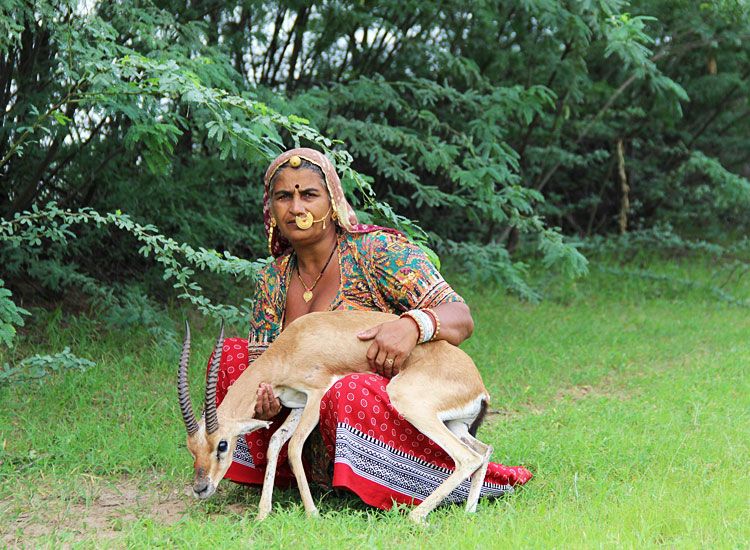
- The people of Bishnoi village are completely unwavering when it comes to the protection of animals and plants in their village. They can even lay their lives for doing so.
- Although the growth of opium is illegal and is banned by the Indian Government, some sects of the Bishnois have the government’s special permission for doing so, for religious tasks.
- Cutting trees is absolutely forbidden in the villages of Bishnois. They do not cremate the dead bodies of deceased people and just bury them.
- Villagers do not wear blue-colored clothes as to get this color, huge quantities of shrubs have to be cut down.
- The women in Bishnoi villages are known for taking care of the rescued calves as their mothers, sometimes even breastfeeding the newborn ones. Once they can walk and feed themselves, they are set free.
- Not many may know about an incident that happened in Bishnoi village was Khejarli Massacre, which happened in the year 1730. At that time 363 Bishnois laid their lives for protecting trees, which were precious to them, as they were being cut by the soldiers of then ruler. When the troops came, the villagers hugged all the trees and did not let them cut trees. Maharaja Abhay Singh honored this act of the villagers and also punished the person who was responsible for the same.
- Awarded as the ‘Best Environment Film’, ‘Willing to Sacrifice’, is based on the life of a Bishnoi, Nihal Chand Bishnoi. He laid his life in October month in the year 1996 to protect the wildlife species of his village. This film was honored at the 5th International Festival of Films, TV, and Video Programs, held in Bratislava, Slovakia.

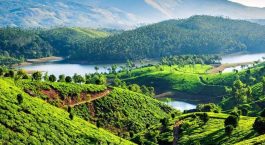

Feeling awosm becoz i am BISHNOI